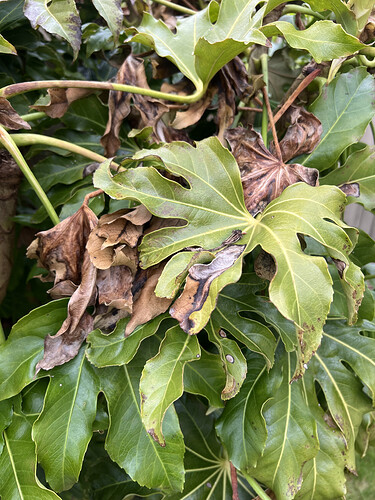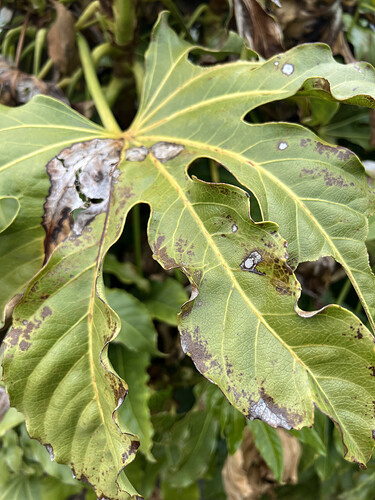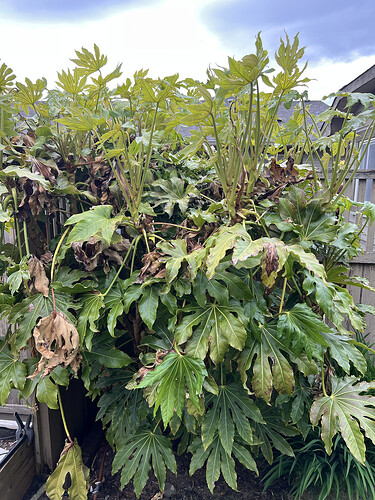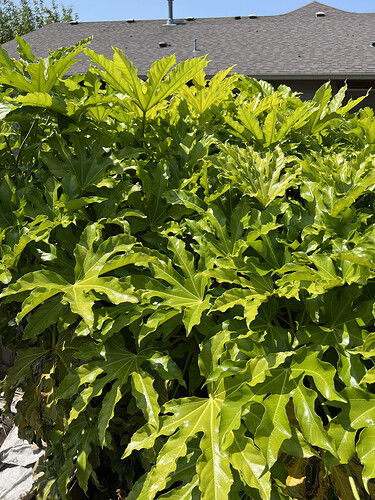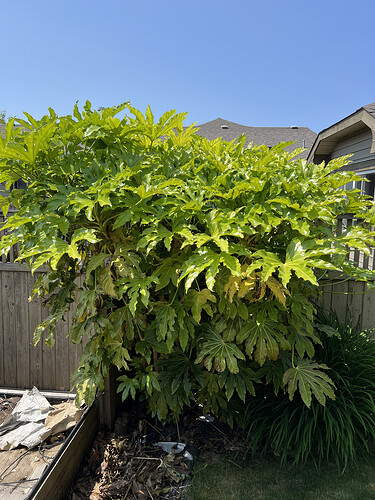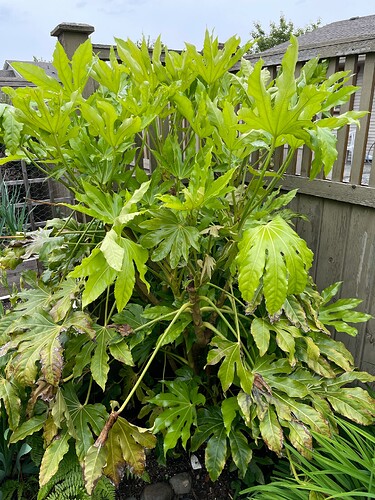Thanks to the Vancouver Island Master Gardener volunteers through the Milner Gardens Gardening Advice line for the following:
————————-
Dear Jono,
Thank you for your questions via the CVHS forum to the Garden Advice Line. First, we agree with the suggestion that this plant is indeed a Fatsia japonica.
Fatsias prefer shade and will produce the best foliage in full shade. They tend to be sensitive to heat. You didn’t mention specifically how many hours of sun this plant gets per day (6 hours would be full sun), and they can tolerate sun, but they thrive in shade.
They prefer moist, well-drained, acidic soils with high organic matter content. Mulching around it can help the soil retain moisture. We tend to have acidic soils here in coastal BC because of all the winter rains, but the moisture and organic matter content are specific to your site, and worth investigating for the health of your plant. You can check the moisture level of the soil by sticking your fingers down into the soil about 6 cm. Adding a little compost each spring can keep the organic matter content levels up as well.
Fatsias are evergreen, but it is important to note that even evergreens must eventually shed their older foliage, which would be at the bottom of the plant. Older leaves dying right as it’s experiencing spring growth makes sense.
That being said, if this plant is getting a lot of sun, and you have a shadier spot with well-drained soil to move it to in your yard, we think the plant could benefit. If you aren’t sure how quickly your soil drains, you could always try a percolation test before transplanting:
- Dig a hole at the proposed new planting site when conditions are dry - and make it approximately 30 cm deep and 10 to 30 cm wide.
- Fill the hole with water and let it drain to saturate the soil.
- Then, immediately fill the hole again.
- Measure with a ruler how much water drains in 15 minutes and multiply this by 4 to get the hourly calculation. Less than 2.5 cm per hour is poorly draining. 10 cm or more per hour is well-drained.
Moving an established shrub can be a considerable task, and the more mature the plant, the increased risk that the transplant will not be successful. We recommend pruning the roots of the shrub in fall, and then transplanting in early spring.
This article is a good explainer on why root pruning helps prepare shrubs for transplanting, and how wide to make the trench based on above-ground size of the plant. By doing this step in fall, your Fatsia will be ready for transplanting in spring:
Here are some tips from the Royal Horticultural Society (RHS) to help things go well when it’s time to move your plant in early spring:
- Water the plant and the new area well the day before
- Do the transplanting on a cloudy day if possible, to reduce sun stress
- Do some careful exploratory digging to see how much root spread there is around the plant - expect it to be at least as wide as the spread of the current plant leaves, possibly more.
- Prepare the area where you are moving the plant first, before digging up the plant. Be sure to make the new planting area wide enough to spread out the roots.
- Keep as much of the roots as possible intact when lifting and digging it out.
- Consider root washing as a way to untangle roots and boost the plant’s chances of success. Root washing is when you remove all of the previous soil off the roots before transplanting. Here is a seminar the Master Gardeners did for the Vancouver Island Regional Library that walks you through the process.
- Have a damp cloth ready to cover the roots while exposed
- Mark the soil line mark on the plant’s main stem(s) so you can plant it at the exact depth as it was previously.
- When placing the plant in its new location, spread out the roots as widely as possible, and be sure to press the soil firmly to ensure no air pockets are present in the hole. Water in well but don’t step on the ground around the root ball. This just compacts the soil and destroys soil structure.
- Mulch 2-4" deep, keeping mulch away from the stem of the plant. Arborists wood chips are the ideal mulch but any plant-based material such as leaves or straw will also work. Although bark mulch is readily available, it is inferior to most other plant-based mulch because it repels water if allowed to dry out, causing any water to run off rather than penetrate to the roots.
- Plan to water the plant regularly for at least the first year to help the plant overcome the stress of being moved and to establish new roots.
Good luck with your Fatsia and happy gardening!
Sincerely,
Vancouver Island Master Gardener volunteers
Sources for this answer:
OSU Landscape Plant Database: Fatsia japonica | Landscape Plants | Oregon State University
Great Plant Picks: Great Plant Picks: Unbeatable Plants for the Maritime Northwest Garden
Testing and Improving Soil Drainage, ISU: Testing and Improving Soil Drainage | Yard and Garden
Tips for Moving Trees & Shrubs:
Need to move a shrub? Prepare them now for moving in the fall or spring, Illinois Extension
![]() but it always looks dreadful at the end of winter, then gets nice looking strong new growth in the spring. If I manually clear out all the dead material it looks great but I wonder if this is diseased, or in the wrong spot? Maybe it needs more shade?
but it always looks dreadful at the end of winter, then gets nice looking strong new growth in the spring. If I manually clear out all the dead material it looks great but I wonder if this is diseased, or in the wrong spot? Maybe it needs more shade?